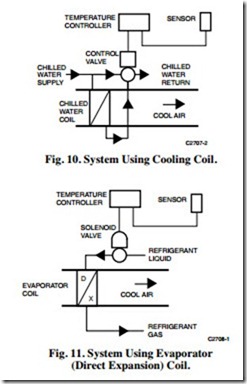COOLING EQUIPMENT
An air handling system cools by moving air across a coil containing a cooling medium (e.g., chilled water or a refrigerant). Figures 10 and 11 show air handling systems that use a chilled water coil and a refrigeration evaporator (direct expansion) coil, respectively. Chilled water control is usually proportional, whereas control of an evaporator coil is two- position. In direct expansion systems having more than one coil, a thermostat controls a solenoid valve for each coil and the compressor is cycled by a refrigerant pressure control. This type of system is called a “pump down” system. Pump down may be used for systems having only one coil, but more often the compressor is controlled directly by the thermostat.
Two basic types of cooling systems are available: chillers, typically used in larger systems, and direct expansion (DX) coils, typically used in smaller systems. In a chiller, the refrigeration system cools water which is then pumped to coils in the central air handling system or to the coils of fan coil units, a zone system, or other type of cooling system. In a DX system, the DX coil of the refrigeration system is located in the duct of the air handling system. Condenser cooling for chillers may be air or water (using a cooling tower), while DX systems are typically air cooled. Because water cooling is more efficient than air cooling, large chillers are always water cooled.
Compressors for chilled water systems are usually centrifugal, reciprocating, or screw type. The capacities of centrifugal and screw-type compressors can be controlled by varying the volume of refrigerant or controlling the compressor speed. DX system compressors are usually reciprocating and, in some systems, capacity can be controlled by unloading cylinders. Absorption refrigeration systems, which use heat energy directly to produce chilled water, are sometimes used for large chilled water systems.
While heat pumps are usually direct expansion, a large heat pump may be in the form of a chiller. Air is typically the heat source and heat sink unless a large water reservoir (e.g., ground water) is available.
Initial and operating costs are prime factors in selecting cooling equipment. DX systems can be less expensive than chillers. However, because a DX system is inherently two- position (on/off), it cannot control temperature with the accuracy of a chilled water system. Low-temperature control is essential in a DX system used with a variable air volume system.
For more information control of various system equipment, refer to the following sections of this manual:
— Chiller, Boiler, and Distribution System Control Application.
— Air Handling System Control Applications.
— Individual Room Control Applications.
